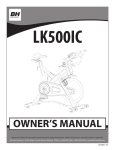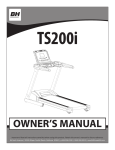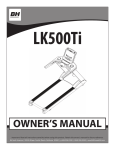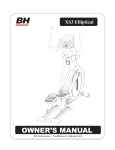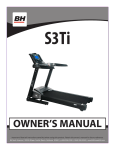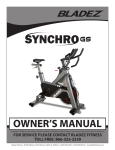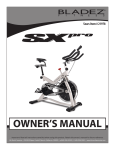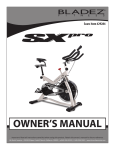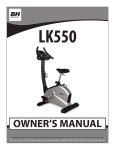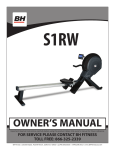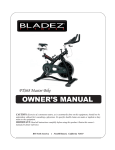Download BH FITNESS SB2.0 Owner`s manual
Transcript
SB2 OWNER’S MANUAL Important: Read all instructions carefully before using this product. Retain this owner’s manual for future reference. BH North America | 20155 Ellipse, Foothill Ranch, California 92610 | p.949.206.0330 | f.949.206.0013 | www.BHFitnessUSA.com TABLE OF CONTENTS TitlePage Introduction03 Warnings & Labels04 Safety Information05 Exercise Instruction06 Training Guidelines07 Workout and Stretching11 Overview13 Assembly Instructions14 Console Overview18 Console Operations19 Exploded View Drawing20 Parts List21 Warranty22 CONGRATULATIONS Congratulations on your purchase of BH Fitness equipment. We hope you appreciate the style, quality, and value that exercisers across North America have come to expect from BH Fitness. If you have any questions, concerns or product issues, please call our Customer Service at 1-866-325-2339 or email us at [email protected]. Carefully read through the instructions contained in this manual. They provide you with important information about assembly, safety, fitness and use of the machine. Please read ALL the safety information contained on the following page. 3 WARNINGS AND LABELS Keep hands and fingers clear of this area. • Misuse of this machine may result in serious injury. • Read User’s Manual prior to use and follow all warnings and instructions. • Do not allow children on or around the machine. • This bike does not free-wheel. Pedals continue to spin when you stop pedaling. • Spinning pedals can cause injury. • Reduce pedal speed in a controlled manner. • The user weight must not exceed 300 lbs/136 kgs. • This product should always be used on a level surface. • Replace label if damaged, illegible or removed. 4 SAFETY INFORMATION PRECAUTIONS The machine has been designed and constructed to provide maximum safety. Nevertheless, certain precautions should be taken when using exercise equipment. Read the whole manual before assembling and using the machine. Please observe the following safety precautions: 1. Keep children and pets away from this equipment at all times. DO NOT leave them unsupervised in the room where the the machine is kept. 2. If you experience dizziness, nausea, chest pains or any other symptom while using this machine STOP the exercise. SEEK IMMEDIATE MEDICAL ATTENTION! 3. Use the machine on a level and solid surface. Adjust the feet for stability. 4. Keep your hands away from any of the joints and moving parts. 5. Wear clothing suitable for doing exercise. Do not wear baggy clothing that might get caught in the machine. Always wear athletic shoes when using the machine and tie the laces securely. 6. This machine must only be used for the purposes described in this manual. DO NOT use accessories that are not recommended by BH Fitness. 7. Do not place sharp objects near the machine. 8. Any person with physical or coordination limitations should not use the machine without the assistance of a qualified person or doctor. 9. Do warm-up stretching exercises before using the equipment. 10.Do not use the machine if it is not working correctly. 11.Before using the machine, thoroughly inspect the equipment for proper assembly. 12.Maintain a clearance of 18 inches in front and to the sides as well as 24 inches to the rear. 13.Use only authorized and trained technicians if a repair is needed. 14.Please follow the advice for correct training, as detailed in the Training Guidelines. 15.Use only the tools provided to assemble this machine. 16.This machine was designed for a maximum user weight of 300 Lbs (136kg) 17.The machine can only be used by one person at a time. 18.The moving pedals can cause injury. Caution: Consult your doctor before beginning to use the machine or any exercise program. Read all of the instructions before using any exercise equipment. KEEP THESE INSTRUCTIONS SAFE FOR FUTURE USE. 5 EXERCISE INSTRUCTION Use of the machine offers various benefits; it will improve fitness, muscle tone and when used in conjunction with a calorie controlled diet, it will help you lose weight. 1. Consult your doctor before starting any exercise program. It is advisable to undergo a complete physical examination. 2. Work at the recommended exercise level. Do not over exert yourself. 3. If you feel any pain or discomfort, stop exercising immediately and consult your doctor. 4. Wear appropriate clothing and footwear for the exercise; do not wear loose clothing; do not wear leather soled shoes or footwear with high heels. 5. It is advised that you do warm-up stretches before working out. 6. Step on to the equipment slowly and securely. 7. Select the program or workout option that is most closely aligned with your workout interests. 8. Start slowly and work your way up to a comfortable pace. 9. Be sure to cool down after your workout. 6 TRAINING GUIDELINES Exercise is one of the most important factors in the overall health of an individual. Listed among its benefits are: • Increased capacity for physical work (strength endurance) • Increased cardiovascular (heart and arteries/veins) and respiratory efficiency • Decreased risk of coronary heart disease • Changes in body metabolism, e.g. losing weight • Delaying the physiological effects of age • Reduction in stress, increase in self-confidence, etc. There are several components of physical fitness and each is defined below. STRENGTH The capacity of a muscle to exert a force against resistance. Strength contributes to power and speed. MUSCULAR ENDURANCE The capacity to exert a force repeatedly over a period of time, e.g. it is the muscular endurance of your legs to carry you 10 km without stopping. FLEXIBILITY The range of motion of your joints. Improving flexibility involves the stretching of muscles and tendons to maintain or increase suppleness, and it provides increased resistance to muscle injury or soreness. CARDIO-RESPIRATORY ENDURANCE The most essential component of physical fitness. It is the efficient functioning of the heart and lungs. AEROBIC FITNESS Is an exercise of relatively low intensity and long duration, which depends primarily on the aerobic energy system. Aerobic means "with oxygen", and refers to the use of oxygen in the body's metabolic or energy-generating process. Many types of exercise are aerobic, and by definition are performed at moderate levels of intensity for extended periods of time. ANAEROBIC TRAINING Is an exercise intense enough to trigger anaerobic metabolism. This means “without oxygen” and is the output of energy when the oxygen supply is insufficient to meet the body’s long term energy demands. (For example, a 100 meter sprint.) 7 OXYGEN UPTAKE The effort that you can exert over a prolonged period of time is limited by your ability to deliver oxygen to the working muscles. Regular vigorous exercise produces a training effect that can increase your aerobic capacity by as much as 20 to 30%. An increased VO2 Max indicates an increased ability of the heart to pump blood, of the lungs to ventilate oxygen, and of the muscles to take up oxygen. THE TRAINING THRESHOLD This is the minimum level of exercise which is required to produce significant improvements in any physical fitness parameter. OVERLOAD This is where you exercise above your comfort level. The intensity, duration and frequency of exercise should be above the training threshold and should be gradually increased as the body adapts to the increasing demands. As your fitness level improves, the training threshold should rise. Working through your program and gradually increasing the overload factor is important. PROGRESSION As you become more fit, a higher intensity of exercise is required to create an overload and therefore provide continued improvement. SPECIFICS Different forms of exercise produce different results. The type of exercise that is carried out is specific to the muscle groups being used and to the energy source involved. There is little transfer of the effects of exercise, i.e. from strength training to cardiovascular fitness. That is why it is important to have an exercise program tailored to your specific needs. REVERSIBILITY If you stop exercising or do not do your program often enough, you will lose the benefits you have gained. Regular workouts are the key to success. WARM-UP Every exercise program should start with a warm-up where the body is prepared for the effort to come. It should be gentle and preferably use the muscles group to be involved later. Stretching should be included in both your warm-up and cool down, and should be performed after 3-5 minutes of low intensity aerobic activity or callisthenic type exercise. WARM DOWN OR COOL DOWN This involves a gradual decrease in the intensity of the exercise session. Following exercise, a large supply of blood remains in the working muscles. If it is not returned promptly to the central circulation, pooling of blood may occur in the muscles. 8 HEART RATE As you exercise, your heart beat increases. This is often used as a measure of the required intensity of an exercise. You need to exercise hard enough to condition your circulatory system, and increase your pulse rate, but not enough to strain your heart. Your initial level of fitness is important when developing an exercise program for you. When starting, you can get a good training effect with a heart rate of 110-120 beats per minute (BPM). If you are more fit, you will need a higher threshold of stimulation. To begin with, you should exercise at a level that elevates your heart rate to about 65 to 70% of your maximum. If you find this is too easy, you may want to increase it, but it is better to lean on the conservative side. As a rule of thumb, the maximum heart rate is 220 minus your age. As you increase in age, your heart, like other muscles, loses some of its efficiency. Some of its natural loss is won back as fitness improves. The following table is a guide to those who are “starting fitness.” Age Target Heart Rate 25 3035404550556065 10 Second Count 23 2222212019191818 Beats per Minute 138 132 132 126 120 114 114 108 108 PULSE COUNT The pulse count (on your wrist or carotid artery in the neck, taken with two index fingers) is done for ten seconds, taken a few seconds after you stop exercising. This is for two reasons: (a) 10 seconds is long enough for accuracy, (b) the pulse count is to approximate your BPM rate at the time you are exercising. Since heart rate slows as you recover, a longer count isn’t as accurate. The target is not a magic number, but a general guide. If you’re above average with your fitness, you may work comfortably a little above that suggested for your age group. The following table is a guide. Age Target Heart Rate 25 3035404550556065 10 Second Count 262625242322222120 Beats per Minute 156156150144138132132126120 Don’t push yourself too hard to reach the figures on this table. It can be very uncomfortable if you over exercise. Let it happen naturally as you work through your program. Remember, the target is a guide, not a rule, a little above or below is just fine. Two final comments: (1) don’t be concerned with day to day variations in your pulse rate, being under pressure or not enough sleep can affect it; (2) your pulse rate is a guide, don’t become a slave to it. 9 MUSCLE SORENESS For the first week or so, muscle soreness may be the only indication you have that you are on an exercise program. This, of course, does depend on your overall fitness level. A confirmation that you are on the correct program is a very slight soreness in most major muscle groups. This is quite normal and will disappear in a matter of days. If you experience major discomfort, you may be on a program that is too advanced, or you have increased your program too rapidly. If you experience PAIN during or after exercise, your body is telling you something. Stop exercising and consult your doctor. WHAT TO WEAR Wear clothing that will not restrict your movement in any way while exercising. Clothes should be light enough to allow the body to cool. Excessive clothing that causes you to perspire more than you normally would gives you no advantage. The extra weight you lose is body fluid and will be replaced with the next glass of water you drink. It is advisable to wear a pair athletic shoes. BREATHING DURING EXERCISE Do not hold your breath while exercising. Breathe normally as much as possible. Remember, breathing involves the intake and distribution of oxygen, which feeds the working muscles. REST PERIODS Once you start your exercise program, you should continue through to the end. Do not break off halfway through and then restart at the same place later on without going through the warm-up stage again. The rest period required between exercises may vary from person to person. 10 SUGGESTED STRETCHES Head Rolls Rotate your head to the right for one count while feeling the stretch up the left side of your neck. Next, rotate your head back for one count, stretching your chin to the ceiling. Rotate your head to the left for one count, and finally, drop your head to your chest for one count. Shoulder Lifts Lift your left shoulder up toward your ear for one count. Then lift your right shoulder up for one count as you lower your left shoulder. Side Stretches Open your arms to the side and continue lifting them until they are over your head. Reach your left arm as far upward as you can for one count. Feel the stretch up your left side. Repeat this action with your right arm. Quadriceps Stretch With one hand against a wall for balance, reach behind you and pull your left foot up. Bring your heel as close to your buttocks as possible. Hold for 15 counts and repeat with right foot up. 11 SUGGESTED STRETCHES Inner Thigh Stretch Sit with the soles of your feet together with your knees pointing outward. Pull your feet as close into your groin as possible. Gently push your knees towards the floor. Hold for 15 counts. Toe Touches Slowly bend forward from your waist, letting your back and shoulders relax as you stretch toward your toes. Reach down as far as you can and hold for 15 counts. Hamstring Stretches Sit with your right leg extended. Rest the soles of your left foot against your right inner thigh. Stretch toward your toes as far as possible. Hold for 15 counts. Relax and then repeat with left leg extended. Calf/Achilles Stretches Lean against a wall with your right leg in front of the left and your arms forward. Keep your left leg straight and the right foot on the floor; then bend the right leg and lean forward by moving your hip toward the wall. Hold, then repeat on the other side for 15 counts. 12 OVERVIEW TOOLS TO USE 1 PC S6 1PC S4 1PC Note: The following tools are included and are the only tools necessary for assembly 13 ASSEMBLY INSTRUCTIONS 1. ASSEMBLY INSTRUCTIONS A second person is recommended when assembling this machine. Take the bike out of its box and check to ensure the parts are undamaged and all the pieces have been supplied. 1. (A) Main body; (B) Handlebar; (C) Handlebar stem; (H) Saddle post; (G) Horizontal saddle tube; (F) Saddle; (I) Rear stabilizer bar with adjustable feet; (J) Front stabilizer bar with wheels; (L) Left pedal; (R) Right pedal; (m) Monitor and (n) mounting bracket; (10) Slotted head bolt M10; (9) Flat washer M10; (8) Cap nut M10; Double ended spanner wrench. 2. See Figure 2. Position the rear stand of the main body (A) on the rear stabilizer bar (I). Insert the bolts (10) from under the stabilizer; place the flat washers (9) and cap nuts (8) and then tighten securely. 3. See Figure 2. Position the front stabilizer bar with wheels (J). Align to the red dots with the wheels facing forwards. Insert the bolts (10) from under the stabilizer; place the flat washers (9) and cap nuts (8) and tighten securely. 14 2. MOUNTING THE PEDALS The assembly instructions for the pedals must be followed exactly, mounting these incorrectly could damage the threads on either the pedal or the crank or both. Right and left refer to the position that the user adopts when sitting on the saddle with the handlebar in front. Figure 3. Thread the right pedal, marked with the letter (R), onto the right crank, also marked with an (R), in a clockwise direction by hand first. Tighten securely with a 15mm wrench (supplied) further. Figure 3. Thread the left pedal, marked with the letter (L), onto the left crank, also marked with an (L), in a counterclockwise direction by hand first. Tighten securely with a 15mm wrench (supplied) further. 3. ATTACH THE SADDLE Figure 4. Place the saddle bracket (F), onto the horizontal saddle tube (G). Hold the saddle in position and tighten both hex nuts on the bracket securely. Slide the horizontal saddle tube (G) through the cavity on the saddle post (H). Figure 5. Position it as desired and tighten the knob (S). Insert the saddle post (H) into the main body (A), position it at the desired height for exercise and tighten the saddle post using the adjustment knob (T) in clockwise direction. ADJUST THE SADDLE HEIGHT Figure 4. Loosen the saddle post adjustment knob (T) slightly by turning it counterclockwise, move the saddle to a position comfortable for doing exercise and then tighten the adjustment knob (T) securely by turning it clockwise. 15 INSTALL & ADJUST THE HANDLEBAR VERTICALLY Attach the handlebar post by sliding it down into the head tube on the frame. Adjust to the desired height using knob (Y) and tighten. Attach the handlebar slider on the handlebar post, use knob (V) to position and secure the handlebar horizontally (Figure 5). ADJUST THE HANDLEBAR HORIZONTALLY Figure 5. Position the handlebar (B) at a comfortable distance for doing exercise by sliding it forth or back on the handlebar stem but without going beyond the “MIN INSERT” marks, then tighten knob (V) securely. 5. ATTACH THE MONITOR Figure 6. Monitor Figure 6. Attach the monitor bracket (n) to the handlebar. Then attach the monitor (m) to the bracket. Connect the computer cable into the jack on the side of the computer. EXERTION SETTINGS Figure 7. To provide an even level of exertion during exercise, this machine is equipped with a tensioning control (Z), located on the stem of the main body (A). This provides various exertion settings when turned. To increase/decrease pedal resistance feel, turn the tensioning control (Z) until the exertion level best suits your exercise requirements. During exercise, the flywheel will get hot due to the braking effect, so when you have finished exercising it is advisable to set the tensioning control (Z) to minimum in order to help stop the brake shoe from hardening. 16 Important: Figure 7. This tensioning control (Z) is linked to an emergency braking system which, when applied with force (as shown in Figure 7), produces a much sharper braking effect. LEVELING Once the unit has been placed into its final position, make sure that it sits flat on the floor and that it is level. This can be achieved by turning the adjustable feet (13) up or down. MOVEMENT & STORAGE Figure 7 and Figure 8. There are wheels (15) at the front of the unit making it easier to move into a chosen position. Push down on the handlebars to lift the rear of the unit up slightly until the wheels touch the floor and roll the bike to the desired location. Store the unit in a dry place, preferably not subject to changes in temperature. 17 CONSOLE OVERVIEW 18 CONSOLE OPERATIONS GENERAL: This console has a LCD which displays; Speed, RPM, Calories, Distance, Time and Pulse (optional). POWER ON/OFF The display will show all data upon pedaling. Once pedaling stops, the LCD will blink, displaying the latest data before pedaling stopped. The display will turn off once pedaling has stopped for over 45 seconds. DISPLAY DATA: A.SPEED Located on top of the LCD display. Shows current speed with pointer. B. TIME Shows total time of the workout. Range: 00:00~99:59 C. RPM Rotation Per Minute. Range: 0~140. If RPM exceeds 140, LCD will show STOP for safety reasons. D. DISTANCE Range: 0~999.9; Change increment: 0.1 miles. E. CALORIES Shows calories consumed during this workout. Range: 000.0~999.9. F. PULSE When using a compatible wireless heart rate chest strap, the bottom of the LCD will show heart rate (chest strap not included). Range: 60~ 240 BPM. 19 EXPLODED VIEW DRAWING 20 PARTS LIST To order replacement parts: provide your customer service representative with the product model number and the part number located on the Parts List below, along with the quanity you require. Item No. 1 2 3 4 5,7 6 8 9 10 11 12 13 14 15 15-1 16 17,18 19 20 21 22 23 24 25 26 27 28 29 30 31 32 Description Saddle Alloy bind clip R & L Lever spring Lever w/washer Crank arm set (5 is left, 7 is right) Outer chain guard Stabilizer nut Stabilizer washer Stabilizer bolt Pedal Rear stabilizer (complete) Adjustment foot Foot tube end cap Wheel Axle bolt for wheel Front stabilizer Brake pad w/holder Screw & nut Spring plate Handlebar Crank bolt Ball bearing Axle set w/ nut Flywheel nut cap Fixed wheel sprocket Flywheel axle w/bearing Computer Water bottle holder Screw for bottle holder Brake system (set) Bolt for front chain guard Item No. 33 34 35 36 37 38 39 40 41 42 43 44 45 45-1 46 47 48 49 50 51 52 53 54 55 56 57 58 59 60 90 Tool Description Front chain guard Water bottle Bolt & washer for spring plate (pc) Chain Handlebar post Rubber sleeves End plug Seat slider Seat post Bolt for outer chain guard Flywheel - Complete Flywheel adjuster bolt Bolt for inner chain guard M6 Bolt for inner chain guard M5 Bolt for sensor support Cable clip Bolt for cable clip Lever fixed bolt Lever plastic washer Lever washer Release lever with washer Fender Fixed Bracket Fender Rear fender bracket Screw Nut Washer Bolt for bracket Left axle cover Sensor and cable Spanner Wrench 21 WARRANTY LIMITED LIGHT COMMERCIAL WARRANTY BH North America will repair or replace, free of charge, at its option, parts that are defective as a result of material or workmanship. Five (5) year warranty coverage on frame and one (1) year on other parts. Labor warranty coverage is one (1) year. Warranty covers the original consumer purchaser only. LIMITED RESIDENTIAL WARRANTY BH North America will repair or replace, free of charge, at its option, parts that are defective as a result of material or workmanship. Lifetime replacement warranty coverage on frame and five (5) years on other parts. Labor warranty coverage is one (1) year. Warranty covers the original consumer purchaser only. THIS WARRANTY DOES NOT COVER • Pre-delivery set-up. • Components that require replacement due to dirt or lack of regular maintenance. • Expendable items which become worn during normal use. • Repairs necessary because of operator abuse or negligence or the failure to operate and maintain the equipment according to the instructions contained in the Owner’s Manual. For more detailed warranty information or to register your product warranty easily online, visit our website at: www.BHFitnessUSA.com FOR WARRANTY REPAIRS, PLEASE DO NOT TAKE YOUR MACHINE BACK TO THE RETAIL STORE. CONTACT BH FITNESS FIRST. BH North America Corporation 20155 Ellipse Foothill Ranch, CA 92610 Phone: 949.206.0330; Toll Free: 866.325.2339; Fax: 949.206.0013 Web: www.BHFitnessUSA.com Mon - Fri 8am - 5pm PST 22






















